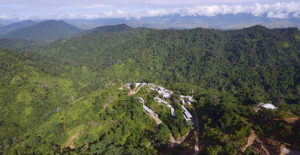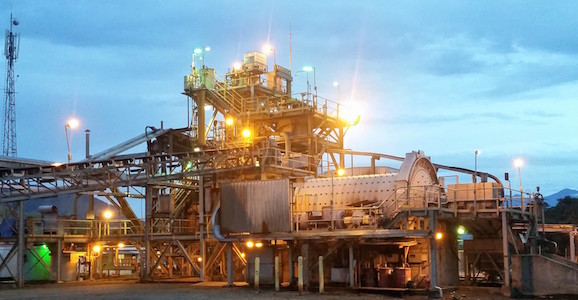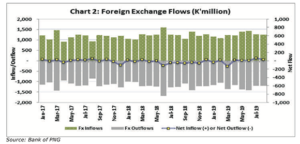The lack of foreign exchange is having a deep impact on Papua New Guinea’s financial system. A new World Bank report shows that mining is the biggest generator of foreign exchange in PNG, but what about LNG?
Mining continues to be the largest source of foreign exchange in PNG but LNG – the country’s number one export commodity – currently contributes little, according to a new World Bank report.
‘Between January and September 2019, the mining sector generated US$1.2 billion [K4 billion] in foreign exchange, principally from Ok Tedi, Lihir Gold and Barrick Niugini. LNG exports, however, generated just US$168 million (K572 million).
Why is this?
‘Because PNG LNG is exempt from the Central Bank Act 2000, revenues from LNG sales abroad are not required to be brought on-shore – the only foreign exchange that returns to Papua New Guinea is to cover local payments,’ the report explains. (Once the debt on the PNG LNG project is paid, this may change).
‘Oil Search sales data for the period January–September 2019 shows that, from sales of approximately US$3.1 billion (K10.2 billion), only US$168 million, or five per cent, was returned to PNG.
‘Both the PNG government and its creditors are betting on there being some future resource boom that will allow the repayment of these debts.’
‘By contrast, revenues in the mining sector were roughly US$3.65 billion [K12.4 billion], of which US$1.2 billion, or 33 per cent, returned to PNG as foreign exchange.’
Money flows
PNG’s foreign exchange situation is being made worse by an outflow of dividend payments, the reports says.
‘While traditionally a small item in the balance of payments, the most recent Bank of Papua New Guinea (BPNG) data show that outflows of dividend payments have increased sharply since 2017, with over K 1,150 million [US$340 million] leaving PNG in the first nine months of 2019 – a 40 percent increase over the same period of 2018,’ according to the World Bank publication.
The World Bank report says that US$5.2 billion (K17.7 billion) flowed out of PNG between January and September 2019 in the form of repatriated profits, dividend payments and debt servicing costs ‘in particular on PNG LNG’.
The document also points out the foreign exchange situation is worsening, with ‘the overall balance registering a deficit of US$300 million (K1.02 billion) in the first nine months of 2019, suggesting that total outflows were greater than total inflows.’
‘A significant share of foreign exchange inflows will also be used to purchase domestic goods and services [thus keeping foreign exchange in the economy].’
These foreign exchange stresses have consequences on PNG’s financial system:
- Monetary policy becomes ineffective. The Kina Facility Rate (KFR), which was introduced by the central bank in 2001 as a reference rate for interbank lending, was designed to be the principal interest rate through which monetary policy should operate in Papua New Guinea.Because commercial banks hold significant excess liquidity (available capital in kina locked inside the domestic economy because it cannot be converted at the required rate into foreign currency), they have not needed to lend to one another and consequently the KFR has proved ineffective. This means the central bank cannot control interest rates in the economy.‘Commercial banks still have cash holdings far above the legal reserve requirement,’ the report explains.
- Government borrowing may become problematic. By borrowing in US dollars in part to cover foreign exchange imbalances, the PNG government is exposing itself to sovereign risk. ‘Borrowing can only prop up foreign exchange reserves for so long,’ explains the report. ‘All borrowing eventually needs to be repaid, with interest. Both the PNG government and its creditors are betting on there being some future resource boom that will allow the repayment of these debts. However, this is a risky strategy. Many country governments borrow to finance investment; investment that will create additional economic activity that can be taxed and used to repay the debt. This is not the case in PNG, where foreign borrowing is largely covering consumption spending, not investing for the future.’
Future prospects

Wafi-Golpu is a joint venture between Newcrest Mining Limited and Harmony Gold Mining Company Limited. Credit: Wafi-Golpu Joint Venture
The World Bank analysis says that, if the Wafi-Golpu and Papua LNG projects go ahead, there will be a construction boom that will result in ‘foreign exchange inflows in the form of foreign direct investment and external borrowing’ that will be used to import goods and services.
‘A significant share of foreign exchange inflows will be used to purchase domestic goods and services [thus keeping foreign exchange in the economy].
‘The latter should help the central bank to replenish international reserves. The economy may start seeing a change in the foreign exchange position from 2022 onward.
‘The next two years will be critical for the authorities to continue adjusting the exchange rate toward its equilibrium while clearing the foreign exchange backlog,’ explains the World Bank.










Speak Your Mind